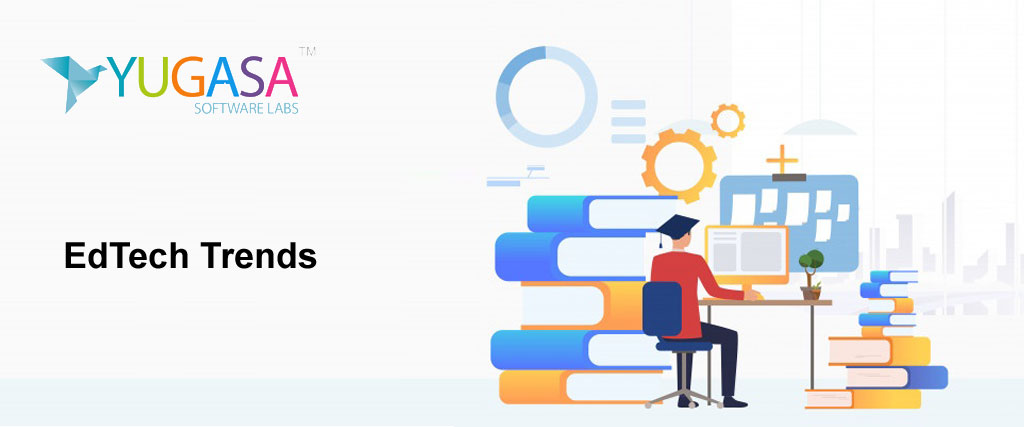Top 6 EdTech Trends For You Should Know in 2020

EdTech Trends 2020: It would be acceptable to all of us. It's not just like another year in 2020. The outbreak of COVID-19 marked the collapse of various successful businesses and associated citizens. Fintech is among the sectors most affected by coronavirus, banking, Insurance, education, travel, and tourism.
However, in spite of the downturn, businesses and structures have learned to overcome the odds and push into alternatives to get it right. EdTech innovations have shaped the education system, in which the pandemic has impacted more than a billion students. It has been shown that virtual classroom design is a valuable solution for the effects of the disease.
Taking into account the way in which education technology opens up new avenues for learners and educational institutions, businesses invested in numerous EdTech app ideas. If you intend to update an existing EdTech system, then there are some EdTech patterns that you need to learn and attempt to follow. When you work on any projects or intend to modernize an existing one. A list of them is given below.
1. ASSISTED VIDEO LEARNING - EdTech Trends 2020
Communication is the key to distance learning. F2F experiences are best to ensure that the learner and the teacher are able to communicate with each other through a smooth conversation. Virtually this can be accomplished by conversation through video.
EdTech is a field that has been able to hold visual conversations by means of video calling or live video sharing. In educational establishments and tutors, students and parents are linked to them by means of one-to-one video conferences or live video sharing.
In addition to the discussion, the resources and software developed for video-assisted learning may lead to motivation and gamification of students.
Gamification in eLearning includes game elements such as tasks, ratings, badges, levels, and so on, which will make learning for learners interesting. A video-assisted learning platform that embraces gamification increases efficiency, encourages interaction and motivation.
2. AI-ASSISTED LEARNING
In the education system, artificial intelligence ( AI) will help to create a customized education program. Intellectual ability, motivation level depending on the student's interest and can be given customized lessons or classes.
Machine Learning ( ML), one of the most common subsets of AI technology, offers a personalized learning experience. On the basis of an array of knowledge, the Machine Learning Models enable students to understand their learning habits and develop the method of teaching and learning. Further information is given to ML models, the results are specific.
AI-based learning will help you to develop a student-centered eLearning application in many ways. The ML algorithms can help to monitor user success on a daily basis such that potential changes can be made in order to optimize education. Machine learning also can monitor the success of a person, which can allow tutors to understand and react to the progress of a student.
3. TV APPS FOR E-LEARNING - EdTech Trends 2020
What every user is looking for is an excellent experience. Therefore, TV apps in the EdTech industry are very popular to make learning attractive and convenient. Also if an EdTech company has smartphone or tablet applications, the development of a TV app would mean improved user experience.
You can create TV apps for different streaming devices including Fire Stick, Android TV, Apple TV, and so on.
The appropriate platform for the OTT app production may be selected, depending on the geography and popularity factor.
Such apps are similar to the smartphone or tablet app, but they do stream content on television.
The educational TV applications can be supplied either with video on request or live streaming options, which allow students to access large-screen content conveniently.
4. ONLINE INDIVIDUAL TUTORING
In the online industry, one-to-one learning is becoming increasingly common, particularly when students are locked out when they can not communicate F2F with the tutors.
There is direct, better contact between the two ends with live video sharing. In addition, on-line tutoring helps tutors to communicate with students in real-time, to consider their questions, and to tailor their lessons to individuals.
5. SYSTEM OF ACCESSIBLE EDUCATION
Accessible education requires the learning system for mentally challenged or learning disabled students. Accessibility in eLearning uses technology to build content such that learners can be reached conveniently regardless of their disabilities.
Technology can allow people with disabilities to learn in various ways. For example, audio and text-to-speak support may benefit visually impaired students. Methods such as the video recording of live sessions will also help individuals with mental or medical concerns understand the principles.
6. DIGITAL WHITEBOARDING
A Digital Whiteboard is a software solution that provides whiteboarding functions such as writing, drawing, and notation. This is separate from an interactive Whiteboard. Digital whiteboards are also used for simple sharing and communication as part of a software package, online and both.
Digital whiteboarding solutions present teachers and students with a number of advantages over their physical versions:
- Screen recording
- Screen sharing
- Virtually infinite board space
- Multimedia options
- Multi-device integration
- Remote input
Digital whiteboards are a flexible teaching tool that can easily be used to distribute content, interact in classes, and store results for analysis or reuse. It would only increase their adoption as supporting equipment gains even further in education.
Read More: WHAT ARE THE TYPES, FEATURES, AND BENEFITS OF E-LEARNING MOBILE APPS?
Development of Ed-tech Software How to Get it Started?
The industry of EdTech is growing. The development team will assist you in the 30-minute, free consulting system, if you are planning to invest in an EdTech company and need technical assistance to get started. Our team will provide you with the right technology foundation, roadmap, and implementation guide, whether you want to create an eLearning platform or to modernize an existing solution.
